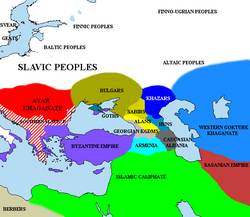
The Göktürks, Türks, Celestial Turks or Blue Turks were a nomadic confederation of Turkic peoples in medieval Inner Asia. The Göktürks, under the leadership of Bumin Qaghan and his sons, succeeded the Rouran Khaganate as the main power in the region and established the First Turkic Khaganate, one of several nomadic dynasties that would shape the future geolocation, culture, and dominant beliefs of Turkic peoples.
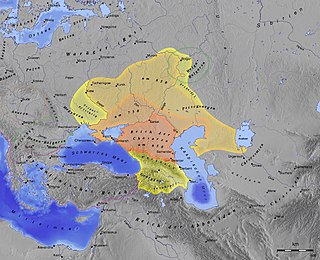
The Khazars were a nomadic Turkic people that, in the late 6th-century CE, established a major commercial empire covering the southeastern section of modern European Russia, southern Ukraine, Crimea, and Kazakhstan. They created what for its duration was the most powerful polity to emerge from the break-up of the Western Turkic Khaganate. Astride a major artery of commerce between Eastern Europe and Southwestern Asia, Khazaria became one of the foremost trading empires of the early medieval world, commanding the western marches of the Silk Road and playing a key commercial role as a crossroad between China, the Middle East and Kievan Rus'. For some three centuries the Khazars dominated the vast area extending from the Volga-Don steppes to the eastern Crimea and the northern Caucasus.

The Turkic peoples are a collection of diverse ethnic groups of West, Central, East, and North Asia as well as parts of Europe, who speak Turkic languages.
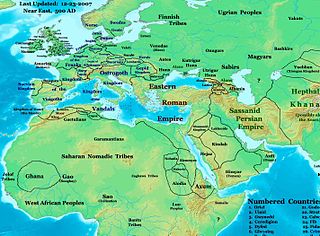
The Sabirs (Savirs, Suars, Sawar, Sawirk among others; were a nomadic Turkic equestrian people who lived in the north of the Caucasus beginning in the late-5th -7th century, on the eastern shores of the Black Sea, in the Kuban area, and possibly came from Western Siberia. They were skilled in warfare, used siege machinery, had a large army and were boat-builders. They were also referred to as Huns, a title applied to various Eurasian nomadic tribes in the Pontic-Caspian Steppe during late antiquity. Sabirs led incursions into Transcaucasia in the late-400s/early-500s, but quickly began serving as soldiers and mercenaries during the Byzantine-Sasanian Wars on both sides. Their alliance with the Byzantines laid the basis for the later Khazar-Byzantine alliance.
The Kabars, also known as Qavars (Qabars) or Khavars were Khazar rebels who joined the Magyar confederation possibly in the 9th century as well as the Rus' Khaganate.

Kubrat was the ruler of the Onogur–Bulgars, credited with establishing the confederation of Old Great Bulgaria in ca. 632. His name derived from the Turkic words qobrat — "to gather", or qurt, i.e. "wolf".
Tarkhan is an ancient Central Asian title used by various Turkic, Hungarian, Mongolic, and even Iranian peoples. Its use was common among the successors of the Mongol Empire and Turkic Khaganate.
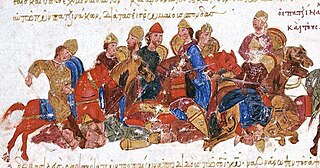
The Pechenegs or Patzinaks were a semi-nomadic Turkic people from Central Asia who spoke the Pecheneg language. In the 9th and 10th centuries, the Pechenegs controlled much of the steppes of southeast Europe and the Crimean Peninsula. In the 9th century the Pechenegs began a period of wars against Kievan Rus', and for more than two centuries launched raids into the lands of Rus', which sometimes escalated into full-scale wars.

The Dulo clan was a ruling dynasty of the Bulgars, who were of Turkic origin. It is generally considered that their elite was related to the Huns and the Western Turkic Khaganate. Particularly, it is said that the Dulo descended from the rulers of Old Great Bulgaria. This state was a centralized monarchy from its inception, unlike previous Hunno-Turkic political entities, which were tribal confederations.
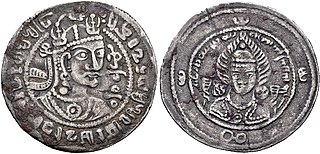
An elteber was a client king of an autonomous but tributary tribe or polity in the hierarchy of the Turkic khaganates including Khazar Khaganate.

Peter Benjamin Golden is an American historian who is "professor emeritus" of History, Turkish and Middle Eastern Studies at Rutgers University. He has written many books and articles on Turkic and Central Asian studies, such as An introduction to the history of the Turkic peoples.
The Turkic migrations were the spread of Turkic tribes and Turkic languages across Eurasia between the 6th and 11th centuries. In the 6th century, the Göktürks overthrew the Rouran Khaganate in what is now Mongolia and expanded in all directions, spreading Turkic culture throughout the Eurasian steppes. Although Göktürk empires came to an end in the 8th century, they were succeeded by numerous Turkic empires such as the Uyghur Khaganate, Kara-Khanid Khanate, Khazars, and the Cumans. Some Turks eventually settled down into sedentary societies such as the Qocho and Ganzhou Uyghurs. The Seljuq dynasty settled in Anatolia starting in the 11th century, resulting in permanent Turkic settlement and presence there. Modern nations with large Turkic populations include Kyrgyzstan, Turkmenistan, Turkey, Azerbaijan, Uzbekistan and Kazakhstan, and Turkic populations also exist within other nations, such as Chuvashia, Bashkortostan, Tatarstan, Northern Cyprus, the Crimean Tatars, the Kazakhs in Mongolia, the Uyghurs in China, the Azeri in Iran, and the Sakha Republic in Siberia.
The Western Turkic Khaganate or Onoq Khaganate was a Turkic khaganate in Eurasia, formed as a result of the wars in the beginning of the 7th century after the split of the First Turkic Khaganate, into a western and an eastern Khaganate.

The Eastern Turkic Khaganate was a Turkic khaganate formed as a result of the internecine wars in the beginning of the 7th century after the First Turkic Khaganate had splintered into two polities – one in the east and the other in the west. Finally, the Eastern Turkic Khaganate was defeated and absorbed by the Tang dynasty, and Xueyantuo occupied the territory of the former Turkic Khaganate.
Tong Yabghu Qaghan was khagan of the Western Turkic Khaganate from 618 to 628 AD. Tong Yanghu was the brother of Sheguy (r. 611–618), the previous khagan of the western Göktürks, and was a member of the Ashina clan; his reign is generally regarded as the zenith of the Western Göktürk Khaganate.
The Oghuric, Onoguric or Oguric languages are a branch of the Turkic language family. The only extant member of the group is the Chuvash language. The first to branch off from the Turkic family, the Oghuric languages show significant divergence from other Turkic languages, which all share a later common ancestor. Languages from this family were spoken in some nomadic tribal confederations, such as those of the Onogurs or Ogurs, Bulgars and Khazars.

Nushibi was a Chinese collective name for five tribes of the right (western) wing in the Western Turkic Khaganate, and members of "ten arrows" confederation found in the Chinese literature. The references to Nushibi appeared in Chinese sources in 651 and disappeared after 766. The Nushibi tribes occupied the lands of the Western Turkic Khaganate west of the Ili River of contemporary Kazakhstan.
IrbisShekui Khagan was the penultimate ruler of the Western Turkic Khaganate. He was linked to the Nushibi faction and was son of El Kulug Shad.

The Tang campaigns against the Western Turks, known as the Western Tujue in Chinese sources, were a series of military campaigns conducted by the Tang dynasty against the Western Turkic Khaganate in the 7th century AD. Early military conflicts were a result of the Tang interventions in the rivalry between the Western and Eastern Turks in order to weaken both. Under Emperor Taizong, campaigns were dispatched in the Western Regions against Gaochang in 640, Karasahr in 644 and 648, and Kucha in 648.

Turkic history is the systematic documentation and study of events involving the Turkic peoples.
